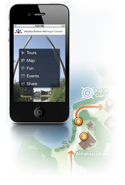Community Embraces New Word Game at Mid-Year Play Day This past Sunday, families at Takoma Park’s Seventh Annual Mid-Year Play Day had the opportunity to experience OtherWordly for the first time. Our educational language game drew curious children and parents to our table throughout the afternoon. Words in Space Several children gathered around our iPads […]
Read moreCategory: Business
 Crowdsourcing can build virtual community, engage the public, and build large knowledge databases about science and culture. But what does it take, and how fast can you grow?
Crowdsourcing can build virtual community, engage the public, and build large knowledge databases about science and culture. But what does it take, and how fast can you grow?
 For some insight, we look at a crowdsourced history site: Historypin is an appealing database of historical photos, with dates, locations, captions, and other metadata. It’s called History “pin” because the photos are pinned on a map. (See recent article about Changes over time, in photos and maps.) Some locations have photos from multiple dates, showing how a place has changed over time, or cross-referenced with Google Maps StreetView. Currently, Historypin has 308k items, from 51k users, and 1.4k institutions. This is a graph of pins over the last three years: (more…)
For some insight, we look at a crowdsourced history site: Historypin is an appealing database of historical photos, with dates, locations, captions, and other metadata. It’s called History “pin” because the photos are pinned on a map. (See recent article about Changes over time, in photos and maps.) Some locations have photos from multiple dates, showing how a place has changed over time, or cross-referenced with Google Maps StreetView. Currently, Historypin has 308k items, from 51k users, and 1.4k institutions. This is a graph of pins over the last three years: (more…)
 Crowdsourcing means involving a lot of people in small pieces of a project. In educational and nonprofit outreach, crowdsourcing is a form of engagement, such as participating in an online course, collecting photos of butterflies for a citizen-science project, uploading old photos for a community history project, deciphering sentences from old scanned manuscripts, playing protein folding games to help scientists discover new ways to fight diseases, or participating in online discussions. (more…)
Crowdsourcing means involving a lot of people in small pieces of a project. In educational and nonprofit outreach, crowdsourcing is a form of engagement, such as participating in an online course, collecting photos of butterflies for a citizen-science project, uploading old photos for a community history project, deciphering sentences from old scanned manuscripts, playing protein folding games to help scientists discover new ways to fight diseases, or participating in online discussions. (more…)
 Imploded by the same forces that have disrupted the broader publishing industry, the dictionary business struggles to get a grip on the online/mobile world. “Our research tells us that most people today get their reference information via their computer, tablet, or phone” said Stephen Bullon, Macmillan Education’s Publisher for Dictionaries, “and the message is clear and unambiguous: the future of the dictionary is digital.” (more…)
Imploded by the same forces that have disrupted the broader publishing industry, the dictionary business struggles to get a grip on the online/mobile world. “Our research tells us that most people today get their reference information via their computer, tablet, or phone” said Stephen Bullon, Macmillan Education’s Publisher for Dictionaries, “and the message is clear and unambiguous: the future of the dictionary is digital.” (more…)
 Too many books? Valuable books? If you or your organization has a library of too many books, consider selling them using Amazon.com fulfillment services. Unlike using eBay or the Amazon ‘Marketplace,’ in exchange for various fees, Amazon handles everything: they pick, pack, ship, and provide customer service for your products. No wasting staff time, or rushing to pack up a book and run to the post office every time someone places an order. Here are step-by-step instructions on how to do it… (more…)
Too many books? Valuable books? If you or your organization has a library of too many books, consider selling them using Amazon.com fulfillment services. Unlike using eBay or the Amazon ‘Marketplace,’ in exchange for various fees, Amazon handles everything: they pick, pack, ship, and provide customer service for your products. No wasting staff time, or rushing to pack up a book and run to the post office every time someone places an order. Here are step-by-step instructions on how to do it… (more…)
 Can profits and kids mix? In a recent edSurge article, Tom Segal argues for the role of the “for-profit” entrepreneurship in the development of educational technology. Profit motives are what spur innovation at the technological level and therefore schools should look to for-profit businesses to further advancements in education-related technology. (more…)
Can profits and kids mix? In a recent edSurge article, Tom Segal argues for the role of the “for-profit” entrepreneurship in the development of educational technology. Profit motives are what spur innovation at the technological level and therefore schools should look to for-profit businesses to further advancements in education-related technology. (more…)
![]() Science journal subscriptions can cost libraries several thousand dollars a year, yet most institutions members only make use of a few articles from each of these journals. The huge subscription expenses limit how many journals each school or company can carry. Even single article pricing can be staggering, at $30-50 each. Sinisa Hrvatin, a doctoral candidate at Harvard, and his roommate Robert McGrath believe they have a better way. (more…)
Science journal subscriptions can cost libraries several thousand dollars a year, yet most institutions members only make use of a few articles from each of these journals. The huge subscription expenses limit how many journals each school or company can carry. Even single article pricing can be staggering, at $30-50 each. Sinisa Hrvatin, a doctoral candidate at Harvard, and his roommate Robert McGrath believe they have a better way. (more…)
 Expand your outreach capacity with multiple media, multiple languages, new sites and apps, and other features by hiring freelancers. Here’s an overview of marketplaces we’ve successfully used at IDEA.
Expand your outreach capacity with multiple media, multiple languages, new sites and apps, and other features by hiring freelancers. Here’s an overview of marketplaces we’ve successfully used at IDEA.
Translations
In our global world, there’s no excuse for staying limited to English speakers, especially when there’s greater need for education in non-English places. Even if you have multilingual staff, most translations will be better and more cost effective if you outsource. Professional translators are efficient, and skilled at adapting idioms and phrases. They tend to be detail-oriented, soft spoken individuals. (more…)
 What was once prohibitively complex and expensive can now be done inexpensively with online testing services. Testing will uncover problems that are confusing for your audience. Here’s a list of vendors to start your research process, and some suggestions.
What was once prohibitively complex and expensive can now be done inexpensively with online testing services. Testing will uncover problems that are confusing for your audience. Here’s a list of vendors to start your research process, and some suggestions.
Three suggestions
For a real-world example on a recent project, designer Ben Snyder said on his blog, “the purpose of the user test is to get feedback about the new design to understand if there are any parts of the website that are confusing to users, and to test the site for hidden bugs that might prevent a user from getting the information they need” or prevent them from completing actions on the site. (more…)


 Advertising is a classic, well-proven way to earn money for a publication, blog or site. “It’s the cost of not having direct, paid reader support,” says
Advertising is a classic, well-proven way to earn money for a publication, blog or site. “It’s the cost of not having direct, paid reader support,” says  It is getting easier and cheaper for cultural and scientific organizations make mobile, handheld tours. According to
It is getting easier and cheaper for cultural and scientific organizations make mobile, handheld tours. According to